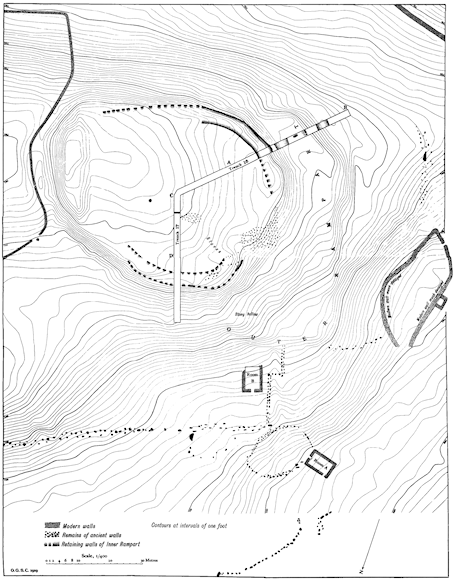
These points regarding contour-plotting can be amplified by reference to one of the more ambitious, some might think curious, archaeological ventures of the early 20th century, taking us back to Crawford. Not surprisingly, his opinions recounted above arose from a position of strength, content that he had already accomplished what he urged upon others, for his 1919 excavations (themselves inadequate) at Pen Dinas, Llanaber, were preceded by what he regarded as his 'most satisfactory achievement' there, being 'the construction of an accurate contoured plan' (Crawford 1920, 116), the culmination of a laborious and methodical campaign of reading spot-heights, aiming to generate contours at a vertical interval of one foot across a steeply undulating area in excess of two hectares (Figure 19).27 Now it may be that Crawford's overt championing of contour-surveying was in part spurred on by retrospective justification of the length of time required to produce his plan of Pen Dinas, but anyway this remains a remarkable record, readily affording a clear, and apparently rigorous, impression of what he termed 'the shape and inequalities of the surface' of both the hillfort and its immediate surrounds. Such metrical utility would not have been feasible in any plan either lacking contours altogether or including them at a wider interval capable only of presenting a summary indication of variability in slope.28 On the other hand, Crawford's plan might be said to disappoint archaeologically because little attempt has been made to distinguish artificial from natural features, allowing the bunching of contour-lines to speak for themselves, even in defining the earthworks of the hillfort.

A contrast is provided by Gresham's (1967) published plan of the same hillfort (Figure 20 — one of his numerous independent surveys, constituting no mean achievement in their own right). This may be more perceptive interpretatively, and it may make a more pleasing image, than Crawford's version, but, in substituting hachures for contours and, of course, in hachuring only selected slopes, Gresham's plan of Pen Dinas lacks the basic information value embedded in the earlier one, giving no useful representation of the vital third dimension of varying steepness of slope. Had Gresham elected to accommodate Crawford's hard-won data rather than eschewing it (always assuming compatible accuracy), he might have found it possible to reach a harmonious mix of contouring, for apparently natural slopes, with hachuring, for apparently artificial ones, perhaps in combination with a range of conventional symbols appropriate to other particulars.

Crawford was not the first to employ close contouring in illustrating the site of a hillfort,29 but it was then, as it remains today, common to take a much more minimalist approach to surface surveying of these monuments. The more simplistic surveys — meaning those in which earthworks, depicted by hachuring, often appear to occupy a flat site (except where exceptionally steep or craggy ground is represented symbolically), so effectively reducing it to two dimensions — became 'normal', and acceptable, in consequence of the OS's understandable exclusion of contours from almost all of the extensive cover of 1:2500 maps which, from late in the 19th century, offered the most accurate of the available records for many hillforts (close contouring of much of the surface of Britain would simply have been too demanding even for a well-resourced OS). Herein lies the problem, for what might be dubbed 'flat-earth mapping' can tell little, frequently nothing, of the manner in which hillfort-builders exploited the natural features of a chosen site or, in some cases, how they coped with the challenges presented by its irregularities and localised peculiarities. It seems certain that many a hill will have been difficult to circumvallate successfully, especially if it is maintained, at least for the sake of argument, that defensibility was a (maybe the) prime concern for those laying out a line for the perimeter of a proposed enclosure, whether intended for palisade, rampart, ditch, wall or whatever form of construction — and it is evident that many hillfort-builders proved themselves to be masters of that art. This being so, we surely should recognise a need to scrutinise, and therefore record, not only the lines of those man-made elements but also the shape of the natural terrain, in both its major and minor features, and to do this in balanced detail. Only thus can there be any hope of appreciating the nature of the task that confronted the builders, and so comprehend their skill, perhaps even their purpose, in any instance. Few would dispute that direct experience of the ground will always be preferable in such matters, but hillforts in Wales are far too numerous and too far-flung for most individuals, even the most assiduous, to acquire more than a passing acquaintance with a wide range of them, making it desirable that each hillfort plan should be capable of standing proxy for personal familiarity with the place.30 Daunting as it may seem, close contouring could provide that extra dimension, allowing the process of mapping any hillfort to 'materially assist progress' more fully than a simplistic two-dimensional plan, both in the sense of improving understanding of the particular example under investigation and in demonstrating comparisons and contrasts with others, so possibly leading to recognition of wider patterns of hillfort castrametation.
Internet Archaeology is an open access journal based in the Department of Archaeology, University of York. Except where otherwise noted, content from this work may be used under the terms of the Creative Commons Attribution 3.0 (CC BY) Unported licence, which permits unrestricted use, distribution, and reproduction in any medium, provided that attribution to the author(s), the title of the work, the Internet Archaeology journal and the relevant URL/DOI are given.
Terms and Conditions | Legal Statements | Privacy Policy | Cookies Policy | Citing Internet Archaeology
Internet Archaeology content is preserved for the long term with the Archaeology Data Service. Help sustain and support open access publication by donating to our Open Access Archaeology Fund.